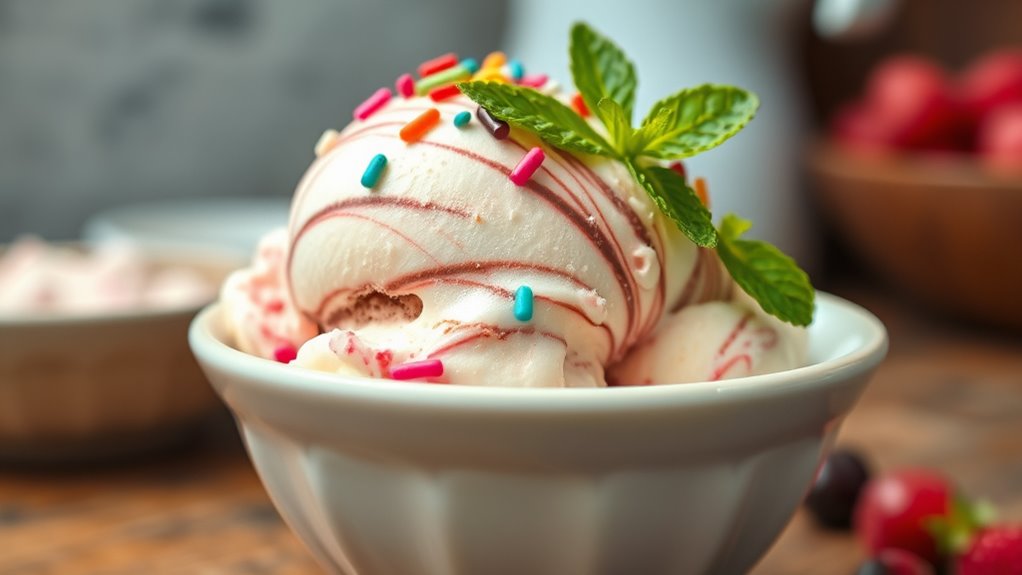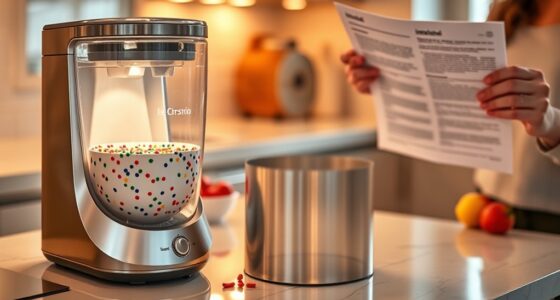To make homemade ice cream so good your friends won’t believe it’s from scratch, start with fresh, high-quality ingredients and incorporate enough fat for a creamy texture. Balance flavors and sweetness carefully, then chill your mixture thoroughly before freezing. Avoid overmixing during churning, and use stabilizers to improve texture. Proper freezing, storage, and creative garnishes also matter. Stick with these tips, and you’ll master the art of irresistible homemade ice cream—discover more tips to impress even further.
Key Takeaways
- Use high-quality, fresh ingredients and natural flavors to create vibrant, complex ice cream that tastes professional.
- Incorporate enough fat, like heavy cream, for a rich, smooth, and scoopable texture.
- Chill your mixture thoroughly, preferably overnight, to improve consistency and prevent ice crystals.
- Properly churn and avoid overmixing to maintain a creamy, velvety texture without ice or graininess.
- Enhance presentation with creative garnishes and toppings to make your homemade ice cream visually irresistible.
Use High-Quality, Fresh Ingredients
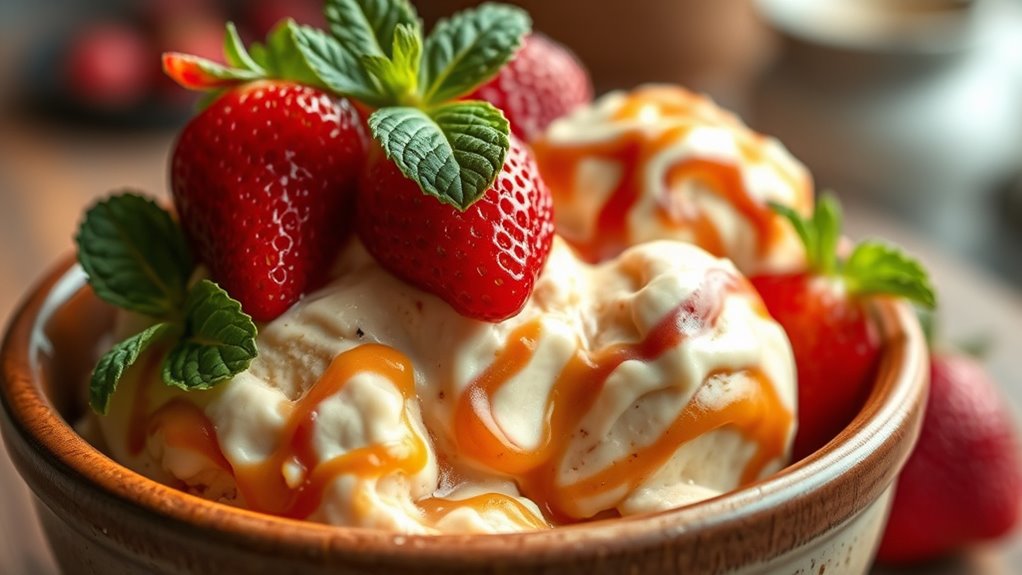
To make ice cream that tastes truly exceptional, start with high-quality, fresh ingredients. Using fresh produce ensures vibrant flavors and better texture, making your homemade ice cream stand out. Whenever possible, choose organic options to avoid pesticides and synthetic additives, which can affect taste and quality. Fresh fruits, like berries or peaches, add natural sweetness and color, elevating your recipe. Fresh dairy, such as whole milk and cream, provides richness and creaminess that store-bought ingredients can’t match. Always select the best ingredients available — quality over quantity makes a noticeable difference. When you start with fresh, organic produce, your ice cream will have a more authentic flavor and a smoother, more indulgent consistency. Incorporating natural farming techniques can further enhance the quality of your ingredients and overall flavor. This foundation sets the stage for a truly delicious homemade treat.
Incorporate Enough Fat for Creaminess
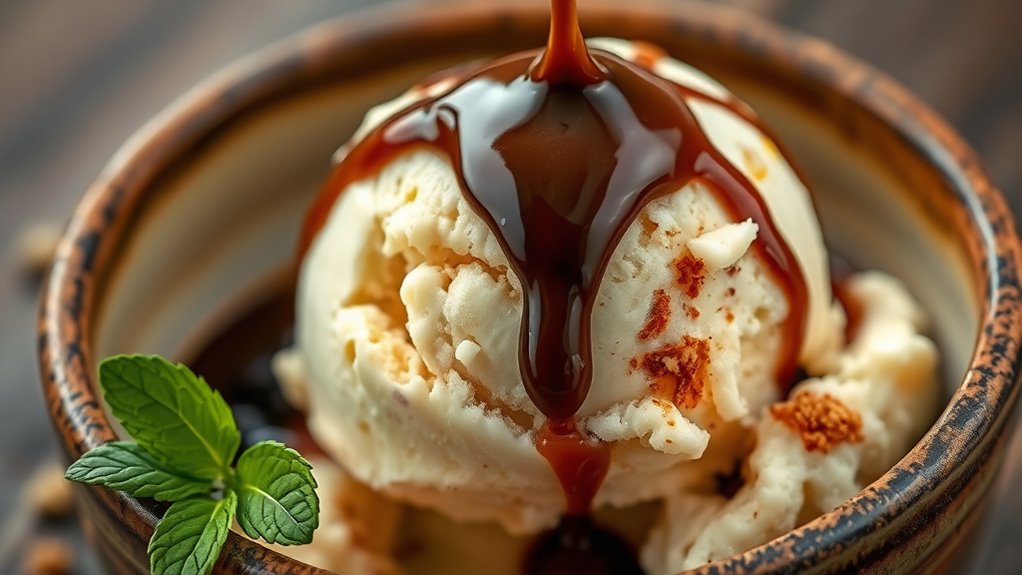
Incorporating enough fat into your ice cream base is essential for achieving that rich, velvety texture everyone loves. The right fat content directly influences creaminess enhancement, making each bite smooth and indulgent. Without enough fat, your ice cream may taste watery or icy. To boost creaminess, use ingredients like heavy cream or full-fat milk, which add essential fat content. This not only improves texture but also enhances flavor depth, creating a luscious mouthfeel. Additionally, fat content plays a crucial role in the overall stability of your ice cream, preventing it from becoming overly hard or crumbly. Be mindful of the balance—too much fat can make it overly rich, so adjust accordingly. Remember, fats are the secret weapon for a luxurious, scoop-worthy ice cream that delights every palate. Optimal fat levels are crucial for the best results in homemade ice cream.
Balance Sweetness and Flavor Enhancers
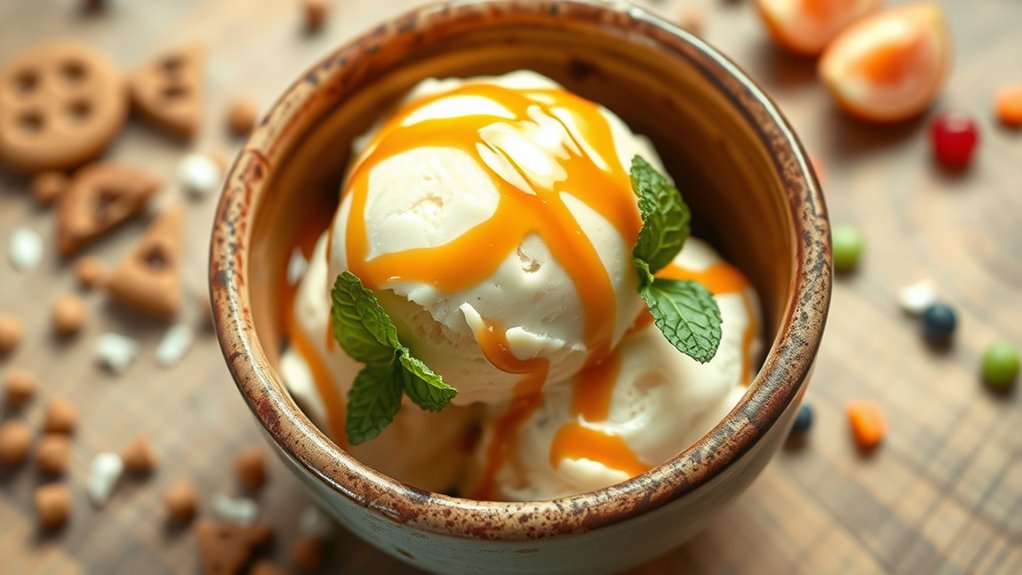
To create a perfectly balanced ice cream, you need to adjust the sugar levels so it’s sweet but not overpowering. Incorporating natural flavors can enhance depth without relying solely on sugar. Additionally, practicing mindful decluttering strategies in your kitchen can help you organize your ingredients and tools more efficiently, making the process smoother. Finally, adding mix-ins like fruit or nuts helps distribute flavor and keeps each bite interesting. Using the right techniques ensures a smooth texture and professional finish.
Adjust Sugar Levels
Adjusting sugar levels is essential for achieving the perfect balance between sweetness and flavor enhancement in your homemade ice cream. Too much sugar can overpower the other flavors, while too little can leave it bland. To perfect your recipe, consider experimenting with sugar substitutes to reduce calories without sacrificing sweetness. Remember, flavor balancing isn’t just about sweetness—it’s about harmony. Tweak the sugar gradually and taste as you go, ensuring each batch improves. Incorporating active listening during taste tests can help you better understand how different adjustments affect the overall flavor profile. Paying attention to color accuracy in your tasting process can reveal subtle nuances in flavor that might otherwise be overlooked. Additionally, understanding the trustworthiness of ingredient sources can ensure you’re using high-quality components for the best results. Recognizing the importance of precise measurements helps maintain consistency and perfect your ice cream’s flavor every time. Being aware of the role of natural sweeteners can also help you create a healthier yet delicious treat. Feel confident knowing you control every flavor nuance – Create ice cream that’s just sweet enough to delight – Avoid overly sugary or bland finishes – Impress friends with a perfectly balanced treat every time
Incorporate Natural Flavors
Adding natural flavors like fresh fruit, herbs, or spices can elevate your homemade ice cream by enhancing its complexity and depth. To maximize flavor extraction, gently heat or muddle your ingredients, releasing more vibrant tastes. Using natural sweeteners, such as honey or maple syrup, helps balance the flavors without overpowering the base’s sweetness. These ingredients add a nuanced layer that enhances the overall profile. Be careful not to add too much, as it can mask the natural flavors or make the ice cream overly sweet. Taste your mixture before freezing, adjusting the flavor extraction and sweeteners accordingly. The goal is to create a harmonious blend where natural flavors shine and complement the sweetness, resulting in a richer, more sophisticated ice cream. Incorporating flavor extraction techniques can further improve the intensity and clarity of your natural ingredients. Additionally, employing sound design principles such as layering and manipulation can inspire creative ways to visualize and conceptualize flavor profiles during the recipe development process. Also, understanding the nutritional properties of ingredients can help you select flavors that not only taste good but also contribute to the health benefits of your ice cream.
Balance With Add-Ins
Balancing sweetness and flavor enhancers is essential to achieving a harmonious homemade ice cream. You want each bite to delight, not overpower. Incorporate fruit combinations that add natural brightness, and consider spice infusions to deepen complexity. These add-ins should complement, not dominate, the base flavor. Using taste balance techniques ensures that the flavors work together seamlessly rather than competing for attention. Additionally, understanding merchant services can help you streamline your ingredient procurement and payment processes for your ice cream business. Think about:
- Pairing tart berries with sweet honey for a perfect balance
- Adding a touch of cinnamon or cardamom to spice infusions
- Using fruit combinations that surprise and excite your taste buds
- Adjusting sweetness after mixing in bold flavors to prevent overwhelming the palate
- Incorporating tuning techniques can help you refine your flavor profile and achieve better harmony in your ice cream. Remembering the importance of believing and emotional alignment to create a memorable culinary experience. Incorporating texture contrast, such as crunchy nuts or chewy swirls, can also elevate the sensory experience of your ice cream. These techniques ensure your ice cream isn’t just sweet but layered with enticing flavors that keep everyone asking for more. Properly balanced add-ins make your homemade treat unforgettable.
Chill Your Mixture Thoroughly Before Freezing
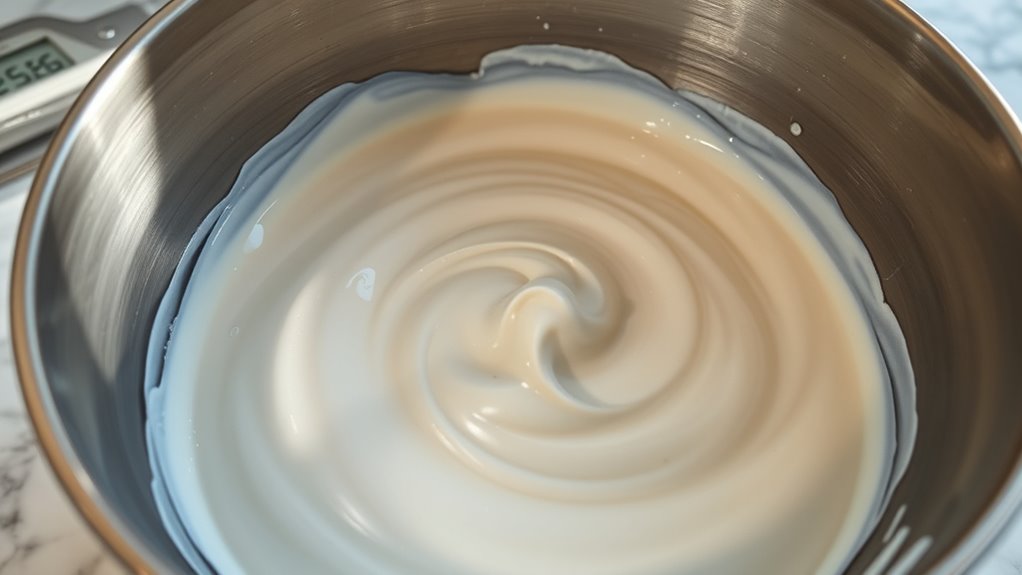
Make certain your mixture is cold before you freeze it. Using chilled ingredients and letting the mixture sit overnight helps it freeze more evenly. This step ensures your ice cream has the ideal texture and flavor. Additionally, incorporating natural ingredients can enhance the overall quality and healthiness of your homemade ice cream. Being aware of AI safety considerations can also help you troubleshoot issues with automated processes in your kitchen. For example, understanding somatic therapy techniques can provide insight into managing stress that might affect your patience during busy baking sessions. Ensuring proper air circulation in your freezer can help maintain consistent temperatures for better freezing results.
Use Cold Ingredients
Have you ever wondered why your homemade ice cream doesn’t turn out as smooth and creamy as store-bought varieties? Using cold ingredients is key. When your mixture is chilled, it freezes more evenly, resulting in a luxuriously smooth texture. If you add frozen fruit directly into your mix, it helps keep everything cold and prevents ice crystals from forming. Using ice cream molds also keeps your mixture colder longer during freezing. Incorporating frozen fruits or herbs can further enhance the flavor and texture of your ice cream. Additionally, understanding freezing techniques can help you achieve professional-quality results at home.
- Achieve velvety texture with perfectly chilled ingredients
- Keep frozen fruit from melting too quickly
- Prevent icy, grainy ice cream
- Make your frozen treats more indulgent and professional-looking
Chilling your mixture thoroughly elevates your homemade ice cream to a level your friends will rave about.
Chill Overnight for Best Results
To achieve the creamiest, most scoopable ice cream, it’s essential to cool your mixture thoroughly before freezing. Letting it rest overnight ensures your flavors meld and the texture becomes smooth. This step improves your freezing techniques and results in better storage tips, preventing ice crystal formation. A well-chilled mixture freezes faster and more evenly. Use the following table to guide your process:
| Step | Tip |
|---|---|
| 1 | Cover tightly to prevent freezer burn |
| 2 | Stir occasionally during chilling |
| 3 | Freeze as soon as the mixture is cold |
Chilling overnight maximizes flavor and texture, making your homemade ice cream irresistible.
Avoid Overmixing During Freezing
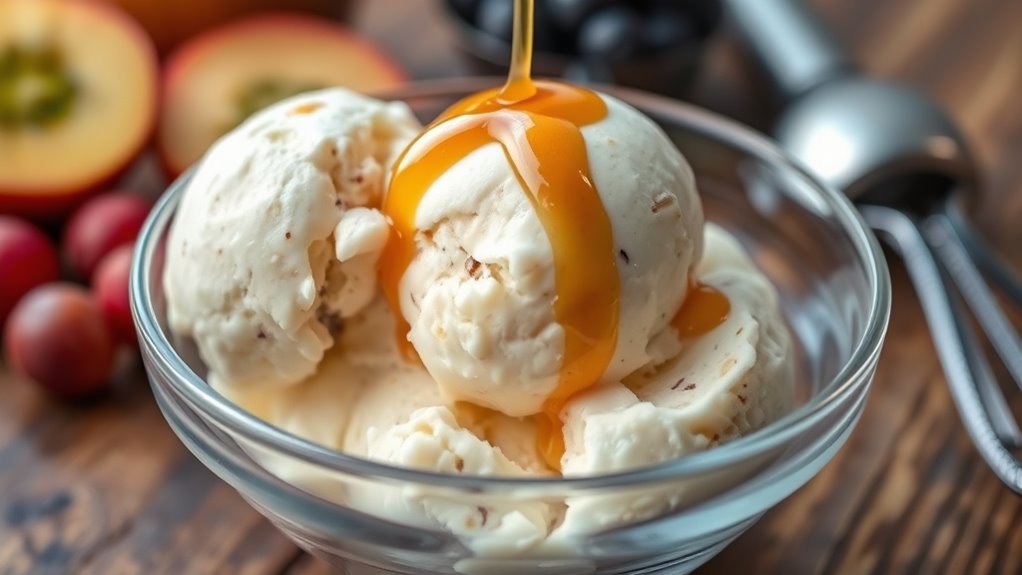
Overmixing your ice cream mixture during freezing can lead to a creamier texture, but going too far can cause it to become icy and grainy. Pay close attention to your mixing speed and freezing duration to avoid this. If you overmix, the ice crystals become too large, ruining the smoothness you desire. To prevent this, stop mixing once the ice cream starts to firm up and thickens. Keep in mind that patience is key—don’t rush the process.
Consider these tips to help you avoid overmixing:
- Monitor your mixing speed carefully, aiming for gentle agitation
- Limit the freezing duration to avoid over-processing
- Use a timer to keep track of your freezing intervals
- Check frequently for the perfect consistency before the final freeze
Experiment With Mix-Ins and Add-Ins
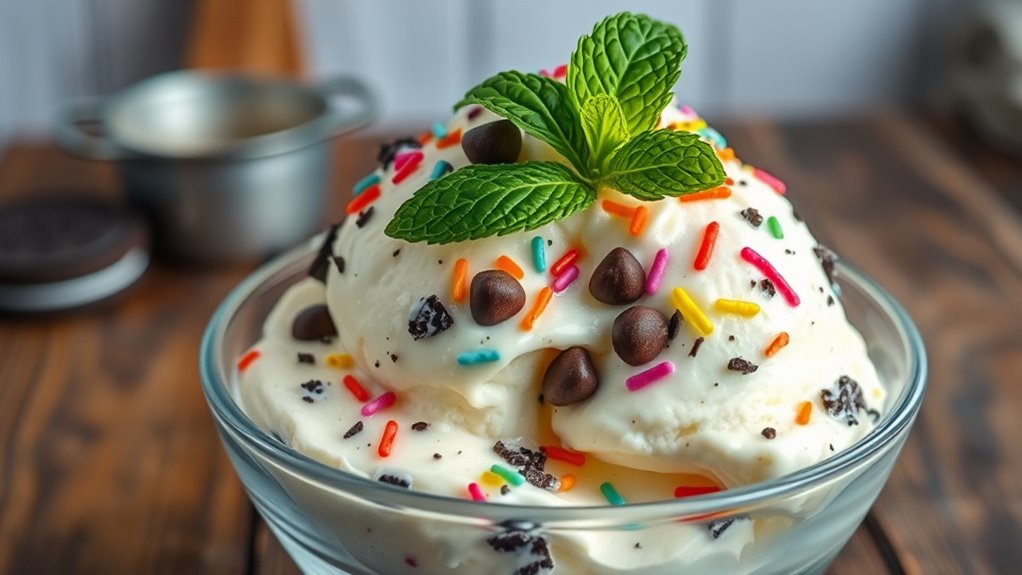
Ever thought about how mix-ins and add-ins can elevate your homemade ice cream? Incorporating fruit infusions adds vibrant flavor and natural sweetness, making each scoop burst with freshness. Try folding in chopped berries, mango chunks, or swirls of fruit puree during the final stages of churning. For added texture, consider crunchy mix ins like toasted nuts, cookie crumbles, or candy pieces. These elements create delightful contrasts and keep each bite interesting. Experimenting with different combinations lets you customize your ice cream to your taste. Just remember to add mix-ins near the end of freezing to prevent sinking or clumping. By playing with fruit infusions and crunchy mix ins, you’ll craft unique flavors that impress your friends and make your homemade ice cream unforgettable.
Use Stabilizers and Emulsifiers for Texture
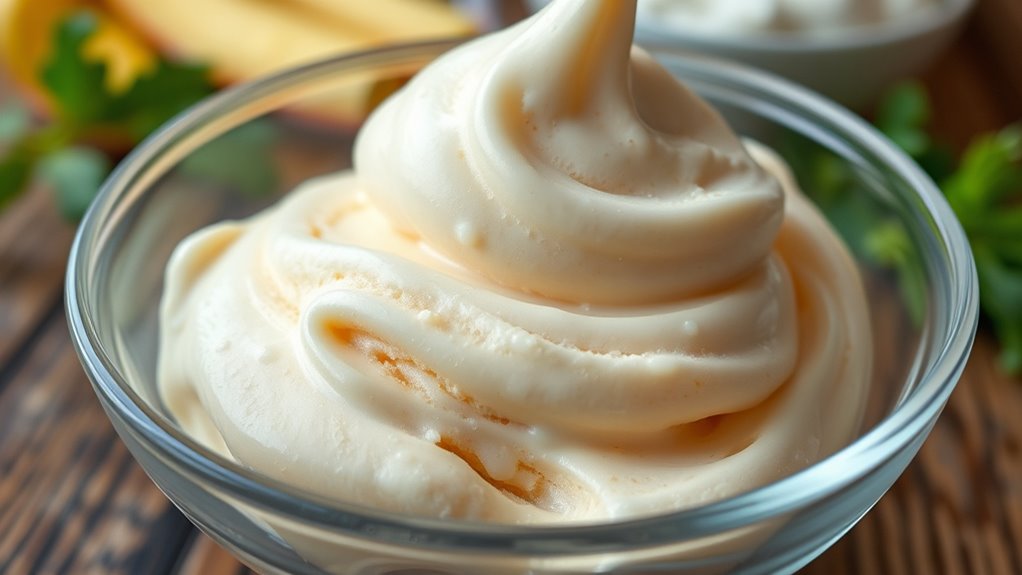
Adding stabilizers and emulsifiers helps create a smoother, creamier texture in your ice cream. They work by preventing ice crystals from forming and making the mixture more uniform. This way, your ice cream stays rich and delicious, just like store-bought varieties.
Improve Creaminess Naturally
To achieve that irresistibly smooth and creamy texture in your homemade ice cream, incorporating natural stabilizers and emulsifiers can make a significant difference. These ingredients help prevent ice crystal formation, ensuring a luxurious mouthfeel. You can enhance creaminess by adding whipped toppings, which naturally contain stabilizers that improve texture. Flavor infusions also benefit from these stabilizers, creating a more cohesive blend of ingredients. Using natural options like gelatin, agar-agar, or guar gum can give your ice cream a professional finish without artificial additives. When combined with proper mixing and churning, these stabilizers elevate your ice cream to store-bought quality. Feel confident knowing your creation will have a velvety consistency that keeps everyone coming back for more.
- Experience a silky, melt-in-your-mouth sensation
- Achieve perfect, scoopable texture every time
- Enhance flavor infusions with richer, more vibrant tastes
- Impress friends with irresistibly creamy homemade ice cream
Prevent Ice Crystals
How can you guarantee your homemade ice cream stays smooth and scoopable without icy patches? Using stabilizers and emulsifiers helps prevent ice crystal formation, which often results from improper freezing methods. These additives improve texture by limiting ice crystal growth during freezing. Choose ingredients like gelatin, cornstarch, or commercial stabilizers to keep your ice cream creamy. Proper freezing techniques, like rapid chilling, also reduce large ice crystals. Here’s a quick guide:
| Stabilizers/Emulsifiers | Freezing Method | Effect on Ice Crystals |
|---|---|---|
| Gelatin | Quick freeze | Smaller, smoother crystals |
| Cornstarch | Chill before freezing | Improved texture |
| Egg yolks | Constant stirring during freezing | Less ice crystal formation |
| Commercial stabilizers | Use in ice cream base | Enhanced creaminess |
| Rapid freezing | Use of ice bath or blast chiller | Keeps ice crystals tiny |
Master the Art of Proper Freezing and Storage
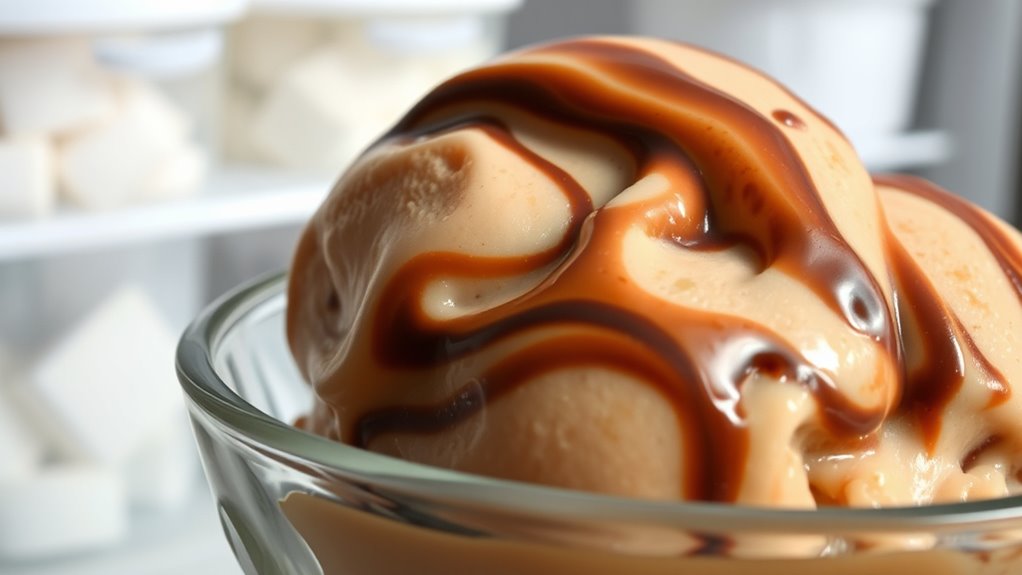
Mastering proper freezing and storage techniques is essential to keep your homemade ice cream fresh and scoopable. Using effective storage tips and freezing techniques ensures your ice cream maintains its creamy texture and flavor. Always store your ice cream in an airtight container to prevent ice crystals and freezer burn. Wrap the surface with plastic wrap before sealing to minimize air exposure. Keep your freezer at a consistent 0°F (−18°C) for ideal preservation. Label your containers with the date to track freshness. Avoid overcrowding the freezer, which can cause temperature fluctuations. Properly stored, your ice cream will stay delicious and ready to impress whenever you serve it.
Proper freezing and storage keep your homemade ice cream fresh, scoopable, and delicious.
- Seal tightly to lock in freshness
- Use airtight containers for long-term storage
- Maintain a consistent freezer temperature
- Minimize air exposure with plastic wrap
Enhance Texture With Proper Churning Techniques
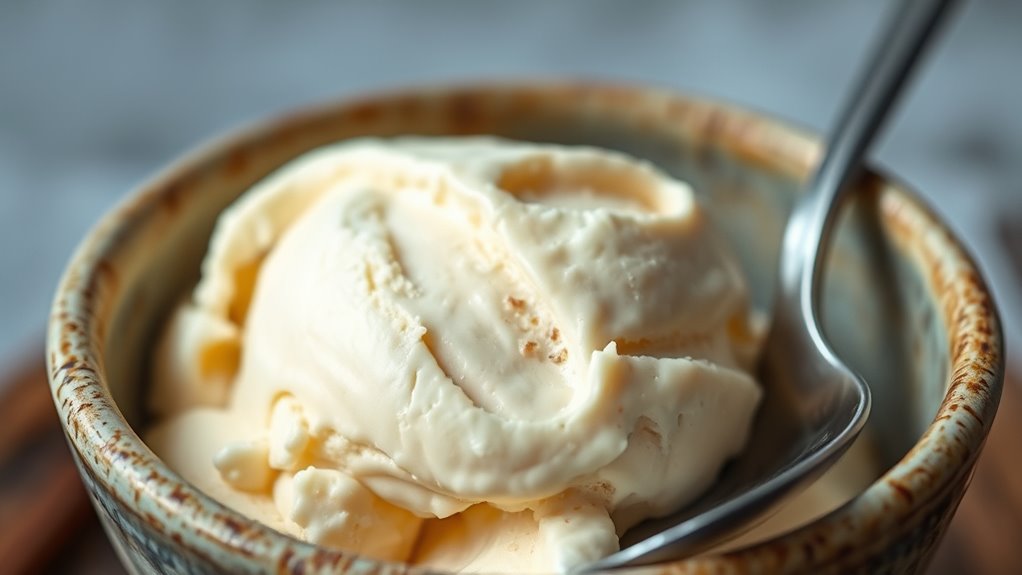
The key to achieving a silky, scoopable texture lies in proper churning techniques that incorporate air evenly into your ice cream. You want to pay close attention to your churning speed; setting it too high can create an airy, icy texture, while too low leads to dense ice cream. The paddle design also plays an essential role—look for paddles that promote consistent movement without over-agitating. Adjusting these factors ensures a smooth, creamy consistency. Here’s a quick comparison:
| Aspect | Effect on Texture |
|---|---|
| Churning Speed | Too fast creates icy texture; too slow may be dense |
| Paddle Design | Proper design ensures even air incorporation |
Focus on these details, and your ice cream will have a professional-quality texture every time.
Garnish Creatively to Elevate Presentation
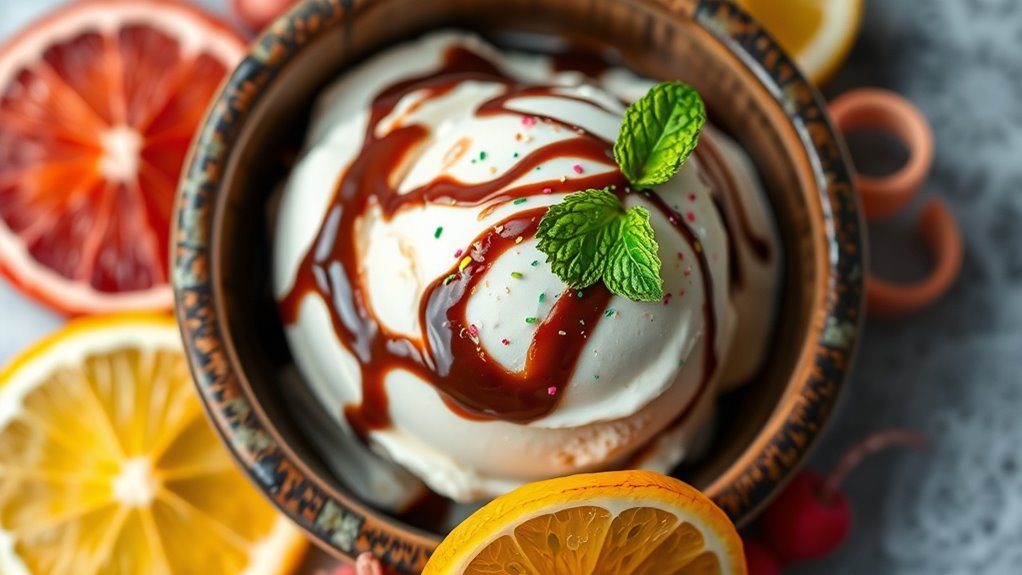
Once you’ve perfected the texture of your homemade ice cream, the next step is to make it visually irresistible. Creative garnishing transforms a simple scoop into a stunning dessert. Use decorative toppings like colorful sprinkles, crushed cookies, or drizzles of caramel or chocolate to add visual excitement. Edible flowers bring elegance and a pop of natural beauty, elevating the presentation instantly. Consider pairing contrasting colors to make each element stand out. A beautifully garnished bowl or cone sparks anticipation and delight. Remember, the eye eats first—so take your time arranging your toppings thoughtfully. Stylish garnishes turn your homemade ice cream into a showstopper, making your friends not only crave the flavor but also enthusiastic to snap photos of your artistic creation.
Frequently Asked Questions
Can I Make Dairy-Free Ice Cream at Home?
Absolutely, you can make dairy-free ice cream at home! Just use dairy alternatives like coconut milk, almond milk, or cashew cream, which work perfectly as bases. Incorporate vegan ingredients such as agave syrup or coconut sugar for sweetness. Blend your chosen vegan ingredients with flavorings like fruit or cocoa, then churn. This way, you create creamy, dairy-free ice cream that’s just as delicious and impressive as traditional versions.
What Are the Best Natural Flavoring Options?
Imagine elevating your homemade ice cream with flavors that surprise and delight. You can achieve this with natural options like fruit infusions, which add vibrant, fresh tastes, or herbal extracts that bring subtle, aromatic complexities. These natural flavorings not only enhance your ice cream’s depth but also keep it healthy. Experiment with berries, mint, or vanilla beans to craft irresistible, authentic flavors your friends will rave about—completely from scratch.
How Long Should I Churn Homemade Ice Cream?
You should churn your homemade ice cream for about 20 to 30 minutes, depending on your churner. Keep an eye on the ice cream texture; it should become thick and creamy. Regular churner maintenance guarantees smooth operation, which helps you achieve the best results. If it’s too soft, freeze it for a few hours. Proper churning time and maintenance make your ice cream irresistibly smooth and delicious.
Can I Store Homemade Ice Cream for Long Periods?
You can store homemade ice cream for several weeks if you use proper ice cream storage techniques. Keep it in an airtight container to prevent freezer burn and maintain freshness. Use effective freezing techniques, like pressing plastic wrap directly on the surface before sealing, to avoid ice crystals. For best results, consume within 2-3 months, and always label with the date to track how long it’s been in your freezer.
What Are Common Mistakes to Avoid in Homemade Ice Cream?
Did you know that nearly 60% of homemade ice cream fails due to common mistakes? To avoid this, don’t skip proper sweetening techniques or ingredient substitutions, which can affect texture and flavor. Avoid overmixing your base, as it causes ice crystals, and neglecting proper churning time. Pay attention to these details, and you’ll craft smooth, creamy ice cream that rivals store-bought varieties.
Conclusion
Now that you know these tips, your homemade ice cream will taste as amazing as it looks—like a masterpiece crafted by a true artist. With fresh ingredients, perfect techniques, and a little creativity, your friends won’t believe it’s made at home. Think of your ice cream as a symphony of flavors, each note playing perfectly. So go ahead, whip up a batch, and enjoy that sweet satisfaction of creating something truly extraordinary from your own kitchen.
